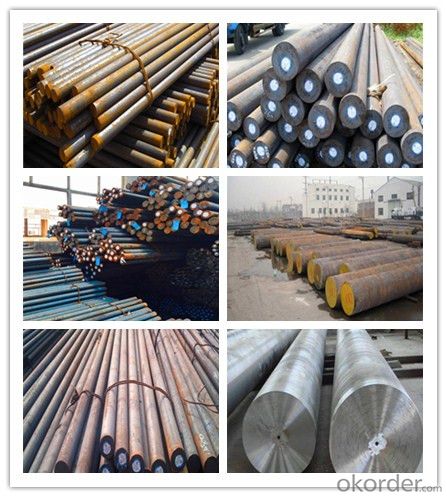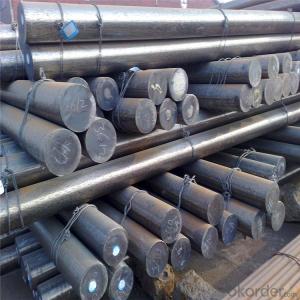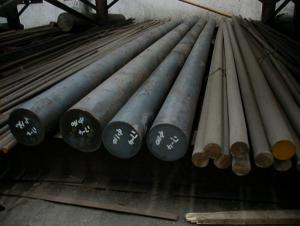DIN1.7225 Alloy Steel Round/Flat/Squar Bar Forged
- Loading Port:
- Tianjin
- Payment Terms:
- TT OR LC
- Min Order Qty:
- 100 m.t.
- Supply Capability:
- 50000 m.t./month
OKorder Service Pledge
OKorder Financial Service
You Might Also Like
Item specifice
DIN1.7225 Alloy Steel Round/Flat/Squar Bar Forged
Product Description of DIN1.7225 Alloy Steel Round/Flat/Squar Bar Forged
1. Steel grade: ASTM4140, SCM440, 42CrMo, DIN1.7225
2. Length: 6M-12M
3. Diameter: 16mm-300mm
4. Product range: round bar, flat bar, square bar
5. Technique: Hot rolled, forged, cold drawn
Specification of DIN1.7225 Alloy Steel Round/Flat/Squar Bar Forged
Material | ASTM4140 | Round bar | Dia(mm) | 16-300mm |
Process | EAF + LF + VD + Forged + Heat Treatment (optional) | Length (mm) | Max 12m | |
Heat treatment | Normalized / Annealed / Quenched / tempered | Flat bar | Thickness(mm) | 8-500mm |
Delivery condition | Hot forged +Rough machined (black surface after Q/T)+ Turned (optional) | Width(mm) | 70-200mm | |
Test | Ultrasonic test according to SEP 1921-84 D/d | Length (mm) | Max 12m |
Chemical Composition of DIN1.7225 Alloy Steel Round/Flat/Squar Bar Forged
C | Si | Mn | Cr | Mo | P | S |
0.38~0.43 | 0.15~0.35 | 0.75~1.00 | 0.8~1.1 | 0.15~0.25 | ≤0.035 | <0.04< td=""> |
Photo Show of DIN1.7225 Alloy Steel Round/Flat/Squar Bar Forged

Packing and Delivery:
Packing in bundle package, or as customer's requirements.
Delivery Detail: 45 days after receiving the deposit.
Usage and Applications of DIN1.7225 Alloy Steel Round/Flat/Squar Bar Forged
1. Steel round bar is used in a large number of architectural and engineering structures. Or it can be used in construction of plants for the production of steel house frames, high-voltage transmission towers, bridges, vehicles, boilers, containers, ships, etc.
2. And we can use this kind of product on the performance of the mechanical parts if the demand is not very high.
3. Some special material steel round bar can be used for main shaft of steamer, hummer shank, with big section and supper force.
Company Information
CNBM International Corporation is the most important trading platform of CNBM group.
Whith its advantages, CNBM International are mainly concentrate on Cement, Glass, Iron and Steel, Ceramics industries and devotes herself for supplying high qulity series of refractories as well as technical consultancies and logistics solutions.


F A Q
1, Your advantages?
professional products inquiry, products knowledge train (for agents), smooth goods delivery, excellent customer solution proposale
2, Test & Certificate?
SGS test is available, customer inspection before shipping is welcome, third party inspection is no problem
3, Factory or Trading Company?
CNBM is a trading company but we have so many protocol factories and CNBM works as a trading department of these factories. Also CNBM is the holding company of many factories.
4, Payment Terms?
30% TT as deposit and 70% before delivery.
Irrevocable L/C at sight.
5, Trading Terms?
EXW, FOB, CIF, FFR, CNF
6, After-sale Service?
CNBM provides the services and support you need for every step of our cooperation. We're the business partner you can trust.
For any problem, please kindly contact us at any your convenient time.
We'll reply you in our first priority within 24 hours.
- Q:What are the different types of steel round bar alloys for improved toughness?
- There are several different types of steel round bar alloys that are known for improved toughness. These alloys are specifically designed to enhance the steel's ability to withstand impact and resist deformation. Some of the commonly used steel round bar alloys for improved toughness include: 1. 4140 Alloy Steel: This alloy is known for its excellent toughness and high tensile strength. It is often used in applications where high impact resistance is required, such as automotive parts, gears, and shafts. 2. 4340 Alloy Steel: Similar to 4140, 4340 alloy steel offers exceptional toughness and strength. It is commonly used in applications where high fatigue resistance is needed, such as aircraft landing gear components and crankshafts. 3. 8620 Alloy Steel: This alloy is ideal for applications that require both toughness and good wear resistance. It is often used in gears, pinions, and other high-stress components. 4. 52100 Alloy Steel: Known for its high toughness and excellent wear resistance, 52100 alloy steel is commonly used in bearings, valve parts, and other heavy-duty applications. 5. H13 Tool Steel: Although primarily used in hot work applications, H13 tool steel is also known for its toughness and ability to withstand high impact loads. It is often used in die casting dies, extrusion dies, and forging dies. 6. A2 Tool Steel: A2 tool steel is another alloy known for its toughness and good wear resistance. It is commonly used in cutting tools, punches, and dies. These are just a few examples of the many different types of steel round bar alloys that are specifically engineered to provide improved toughness. The selection of the appropriate alloy depends on the specific application requirements and the desired level of toughness needed.
- Q:What are the different surface treatments available for carbon steel round bars?
- Some of the different surface treatments available for carbon steel round bars include hot dip galvanizing, electroplating, black oxide coating, powder coating, and painting. These treatments help to improve the appearance of the steel, protect it from corrosion, and enhance its durability.
- Q:Can steel round bars be used in the automotive manufacturing?
- Yes, steel round bars can be used in automotive manufacturing. Steel round bars are commonly used in the production of various automotive components such as axles, crankshafts, connecting rods, and suspension parts. They offer excellent strength, durability, and impact resistance, making them suitable for withstanding the rigorous demands of automotive applications. Additionally, steel round bars can be easily machined and fabricated to meet specific design requirements, ensuring precise and reliable performance in the automotive industry.
- Q:What is the difference between a centerless ground and a cold finished steel round bar?
- Both centerless ground steel round bars and cold finished steel round bars are types of steel bars that have undergone different manufacturing processes, resulting in distinct characteristics and properties. To produce a centerless ground steel round bar, a hot rolled or cold drawn steel bar is fed through a grinding machine. This grinding process eliminates any surface imperfections or irregularities, resulting in a smooth and uniform surface finish. Additionally, the centerless grinding process ensures precise dimensional tolerances, making the bar suitable for applications that require accurate measurements. Furthermore, centerless ground bars have improved straightness and roundness, enhancing their overall quality and suitability for various machining operations. On the other hand, a cold finished steel round bar is created by cold drawing or cold rolling a hot rolled steel bar. This process involves reducing the diameter of the bar while maintaining its length, resulting in a more precise and consistent size. Cold finishing also enhances the surface finish of the bar, making it smoother and more uniform. Cold finished bars have tighter dimensional tolerances and improved mechanical properties, including higher strength and hardness compared to hot rolled bars. In conclusion, the primary distinction between centerless ground and cold finished steel round bars lies in their manufacturing processes and resulting characteristics. Centerless ground bars possess a smooth surface finish, tight dimensional tolerances, improved straightness, and roundness, rendering them suitable for precise machining applications. On the other hand, cold finished bars offer a more precise size, improved surface finish, tighter dimensional tolerances, and enhanced mechanical properties, making them suitable for various applications requiring higher strength and hardness.
- Q:What is the maximum silicon content allowed for steel round bars?
- The maximum silicon content allowed for steel round bars can vary depending on the specific grade and application of the steel. However, in general, the maximum silicon content for most standard carbon and alloy steels used in round bars is typically around 0.35% to 0.45%. Exceeding this limit can lead to detrimental effects on the steel's mechanical properties, such as reduced toughness and increased brittleness. It is important to consult the relevant industry standards and specifications to determine the specific maximum silicon content allowed for a particular steel grade and intended use.
- Q:What are the common defects found in steel round bars?
- Some common defects found in steel round bars include surface cracks, internal voids or inclusions, dimensional variations, and improper heat treatment. Other defects may include decarburization, surface scaling, or surface pitting. These defects can affect the mechanical properties and performance of the steel bars, potentially leading to reduced strength, brittleness, or failure under stress. Regular quality control and inspection processes are necessary to identify and address these defects to ensure the integrity and reliability of the steel round bars.
- Q:How do you calculate the maximum allowable stress for a steel round bar?
- To calculate the maximum stress that a steel round bar can bear without deforming or failing, several considerations must be made. 1. Material properties must be determined: Steel round bars have various grades, each with its own distinct material properties. These properties, such as ultimate tensile strength (UTS), yield strength, and elongation percentage, can usually be found in material specification documents or reference books. 2. The design factor should be identified: The design factor, also referred to as the safety factor or factor of safety, is a multiplier applied to the maximum stress to ensure the safety and capacity of the structure or component when subjected to unexpected or dynamic loads. The design factor can differ depending on the application and industry standards, typically ranging between 1.5 and 4. 3. The allowable stress needs to be calculated: The allowable stress is determined by dividing the yield strength of the material by the design factor. This calculation ensures that the structure or component remains within a safe stress range. The formula can be expressed as: Allowable Stress = Yield Strength / Design Factor. For instance, if a steel round bar has a yield strength of 300 MPa and a design factor of 2, the maximum allowable stress would be 150 MPa (300 MPa / 2). This implies that the steel round bar can safely endure a maximum stress of 150 MPa before the risk of deformation or failure arises. It is vital to note that the maximum allowable stress is just one aspect of designing a structure or component. Other factors, including fatigue, environmental conditions, and load distribution, should also be considered to ensure a secure and dependable design. Seeking guidance from relevant engineering codes, standards, and professionals is highly recommended when calculating the maximum allowable stress for a specific application.
- Q:What are the advantages of using nickel-chromium alloy steel round bars?
- Using nickel-chromium alloy steel round bars in various applications offers several benefits. Firstly, these round bars possess outstanding corrosion resistance properties. The inclusion of nickel and chromium elements in the alloy enhances its ability to withstand corrosion from moisture, chemicals, and oxidation, making it suitable for use in challenging environments like marine applications, chemical processing plants, and oil refineries. Secondly, these round bars exhibit high temperature resistance. The combination of nickel and chromium in the alloy allows it to endure elevated temperatures without compromising its structural integrity. This makes them ideal for use in heat exchangers, furnaces, and other high-temperature applications. Furthermore, these round bars boast exceptional mechanical properties. They demonstrate excellent strength, toughness, and wear resistance, making them ideal for applications that require high load-bearing capabilities. Additionally, they exhibit good ductility, enabling easy machining and fabrication. Additionally, these round bars possess good electrical conductivity, making them suitable for electrical and electronic applications where conductivity is crucial, such as in the manufacturing of resistors, heating elements, and electrical connectors. Lastly, these round bars are readily available and cost-effective. Being a widely used material in various industries, they are easily accessible and can be obtained at competitive prices. In conclusion, the advantages of utilizing nickel-chromium alloy steel round bars encompass excellent corrosion resistance, high-temperature resistance, superior mechanical properties, good electrical conductivity, and cost-effectiveness. These characteristics make them the preferred choice for a wide range of applications in industries such as construction, automotive, aerospace, and electrical engineering.
- Q:What is the difference between a solid steel round bar and a hollow steel round bar?
- A solid steel round bar is a cylindrical metal rod that has a uniform diameter throughout its entire length. It is made of solid steel, meaning it does not have any hollow or empty space inside. On the other hand, a hollow steel round bar also has a cylindrical shape but contains a hollow or empty space within its center. This hollow space can vary in size, depending on the specific design and purpose of the hollow round bar. The main difference between the two lies in their structural integrity and weight-bearing capacity. A solid steel round bar offers greater strength and stability compared to a hollow steel round bar. This is because the solid bar is made of a continuous steel material, making it more resistant to bending, twisting, or deforming under pressure. It is commonly used in applications where high strength and durability are required, such as construction, engineering, and manufacturing industries. In contrast, a hollow steel round bar may have reduced strength and load-bearing capacity due to the presence of the hollow space within. However, the hollow design provides certain advantages in terms of weight, cost, and flexibility. The hollow space allows for a lighter overall weight of the bar, making it more suitable for applications where weight is a critical factor, such as aerospace or automotive industries. Additionally, the hollow space can be utilized for various purposes, such as passing through electrical wires or fluids, providing a channel for ventilation, or even reducing material costs by using less steel. Ultimately, the choice between a solid steel round bar and a hollow steel round bar depends on the specific requirements of the application. If strength and stability are paramount, a solid bar would be the preferred choice. Conversely, if weight reduction, cost-efficiency, or additional functionality is desired, a hollow bar may be more suitable.
- Q:Can steel round bars be used in the production of HVAC equipment?
- Yes, steel round bars can be used in the production of HVAC equipment. Steel round bars are often used to create the structural framework and components of HVAC systems. They provide strength, durability, and stability necessary for various parts such as supports, brackets, and frames. Additionally, steel round bars can be easily fabricated, welded, and shaped to meet the specific requirements of HVAC equipment.
1. Manufacturer Overview |
|
|---|---|
| Location | |
| Year Established | |
| Annual Output Value | |
| Main Markets | |
| Company Certifications | |
2. Manufacturer Certificates |
|
|---|---|
| a) Certification Name | |
| Range | |
| Reference | |
| Validity Period | |
3. Manufacturer Capability |
|
|---|---|
| a)Trade Capacity | |
| Nearest Port | |
| Export Percentage | |
| No.of Employees in Trade Department | |
| Language Spoken: | |
| b)Factory Information | |
| Factory Size: | |
| No. of Production Lines | |
| Contract Manufacturing | |
| Product Price Range | |
Send your message to us
DIN1.7225 Alloy Steel Round/Flat/Squar Bar Forged
- Loading Port:
- Tianjin
- Payment Terms:
- TT OR LC
- Min Order Qty:
- 100 m.t.
- Supply Capability:
- 50000 m.t./month
OKorder Service Pledge
OKorder Financial Service
Similar products
New products
Hot products
Related keywords


































